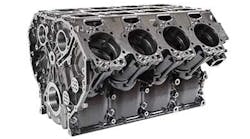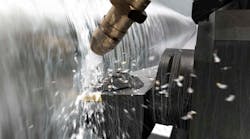When a machining operation — either an OEM division or a job shop — makes the substantial investment in a new lathe, it’s likely they are looking for ways to streamline the manufacturing process. Being smart about choosing the live tools for the job will make the new machines more efficient in operation. Finding a supplier of live tools that offers high-quality, high-performance products that will allow you more flexibility on the first big job and into the future is critical to the selection.
The first tool feature to consider is the output that is required. Standard ER output or quick-change? Do you need through-the-tool cooling? Does the tool meet your requirements for precision and performance, including the necessary torque output to complement the machine? Are the tools designed according to the specifications of the lathe manufacturer?
When you consider a tool’s ER output, will it provide enough flexibility, will a more advanced machining system be needed — one capable of using the same tool for different applications. If more flexibility is required, then consider tooling with a system that features adapters for a variety of tools without the cost of complete toolholder assemblies for each tool needed.
However, when considering such systems, make certain they feature a rigid polygon drive system design to prevent power transmission and alignment problems. Such systems are appealing, because the live tool stays in place and only the adapter and collet get changed with each new tool. However, less sophisticated, though inexpensive, systems will compromise the accuracy of the work. At that point, the capital savings will mean very little compared to the scrap and downtime that results.
If changeover time is critical, such as when producing a family of parts, the option of a true quick- change system might be more beneficial. Adapters can be set offline and ready to go for minimal changeover time.
Coolant-thru systems
When coolant-through tools are selected, it is imperative to check first that the machine specifications allow the choice of a tool that’s capable of handling the coolant pressure of the machine. In general, internal coolant live tools should be able to handle 1,000 psi or more.
If your live tool is constructed with large, high-accuracy bearings, the tool will have excellent rigidity and premium cutting performance, with minimal run-out (0.0002 in. or 0.006 mm is a desirable goal.) The bearings, combined with ground, paired, and high-accuracy gears, make for consistent and long-lasting tools. Bore tolerance is absolutely critical to maintaining proper bearing load, and this factor should never be compromised.
In addition, consider the many applications that can be accomplished with the proper live tool. You can purchase speed increasers for higher rpm, gear reducers for added torque, adjustable angle tools for compound angles, multiple-spindle tools for additional capacity, or gear hobbing tools for spline or gear cutting. Most of those items are standard catalog devices, but one more piece of advice: do not automatically avoid the custom tool, when appropriate and justified by the job you have in-shop today, as well as the ones you might have tomorrow. A good tooling supplier will work with you to produce custom tools at reasonable prices, but the supplier must be very reliable. Look for suppliers that have in-house grinding, finishing and perhaps even heat treating, or at least ensure that those production processes are very closely monitored. Additionally, be certain the supplier you choose has local support and the tools can be repaired or reworked quickly, and correctly.
Selecting materials
The workpiece materials are always a determining factor. Machine shops producing medical or surgical components understand this. Buying a less expensive or “lower featured” tool to work cobalt chromium and titanium is a bad idea.
Practically speaking, always check a supplier’s inventory and source of supply. Today, when customers are demanding faster response times and more cost off-loading, you must expect the same from your tooling supplier. Likewise, application and engineering assistance should be available from local sources to support your tool choices.
The bottom line is the bottom line, but when you’re selecting tooling systems for new or even your current lathes, you must always consider the jobs you expect to handle in the future. What seems to be a bargain might not be one after the first big job is completed.
DIN and ABEC standards are the norm, and your supplier should be willing to supply all necessary documentation on request. Shortcuts on quality are never worth the short-term savings.
Preben Hansen is the president of Heimatec Inc. Contact him with inquiries, or visit www.heimatecinc.com







